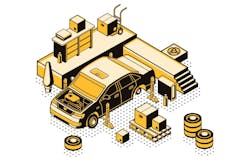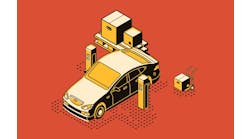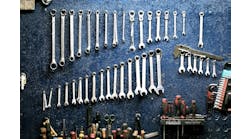What’s more important—a technician with the right tools or an optimized
space enabling them to succeed?
The answer is both, actually, as the whole is much greater than the sum of the parts. When technicians have the tools and technology to streamline the diagnosis and repair process—and when the space around them not only allows but encourages swift, accurate work with a sensible floor plan—you’ve empowered some of the primary factors to increase total shop efficiency.
Workflow is situational and unique to each shop—a complicated dance of efficiencies, analysis and even a few errors. Fortunately, good managers learn from their mistakes and adapt their team and tools as the situation demands.
Make the Shop Floor Work for You
Any space can be optimized to suit the needs of those within. In boxing, Muhammad Ali famously used the rope-a-dope strategy, prancing around his opponents, jabbing here, blocking there, waiting until their stamina ran thin before really engaging too much. He turned the boxing ring—flat, square, unadorned—into his space. Boxers entered his arena.
Shop owners have the same opportunity (if not the same notoriety). Any floor can
be optimized; any bay can be poised to run at maximum efficiency. But it requires
a game plan and clear communication with the staff. Most shops don’t have the luxury of just planning a new floor space—especially in the COVID era—but they still require a clear idea and a goal regarding what kind of shop you want to be; what kind of vehicles do you work on? What can your technicians do, and what is the proper labor and parts matrix to offer the most value at the best price for your customers and for your business? Who is your ideal customer? How will you utilize slower days to cross-train or cleanse?
And how will you use these answers to plan the space you have?
If you desire to specialize in more serious repairs and higher AROs, ensure that your shop floor reflects that with the tools and technology to assist your team as they tear apart a car and get ready for the next round. If you want to fight, you’ve got to cut weight. Drop the habits and practices holding you back, develop new strategies to maximize your strengths and step back into the ring.
Plan Every Day
Does your team know the plan for the day by 8:00 a.m.? If not, it’s time to reconsider how they spend their time (and maybe how you spend yours).
Employee handbooks. Detailed job descriptions. Daily expectations. Standard operating procedures. These are all methods to help streamline your shop each and every day, and while the daily workload is unique, the workflow is manageable and should be controlled. Use a dry erase board, a vehicular color coding system, digital tablets or shop TVs—whatever you need so the team has eyes on the entire shop, every employee and repair. Some owners hold a daily meeting before the coffee is out while others opt for an end-of-day meeting to discuss the day’s challenges and opportunities and prepare for tomorrow.
Technology will increasingly dictate the workflow in the contemporary repair shop, so embrace it—many tools and software programs integrate seamlessly with your existing software for wireless and instant communication and documentation. In fact, the most efficient shops should be able to communicate without talking, eliminating the “walk and talk” / casual banter that can chip away at efficiency minute by minute.
For service advisors, technology can eliminate communication bottlenecks such as
phone tag. Instead of chasing customers, send a text—digital vehicle inspections
(DVI) show the necessary repair instead of asking clients to imagine it, offering an easy opportunity for education and a much higher chance of swift approval for repair services. The average response time to a voicemail is three hours opposed to three minutes for a text. Again, it’s all about making those in your ring play your game.
Technician Efficiency 101
Measure technician efficiency to put a number and formula behind your team’s hours and repairs, then improve it
—
Simply put, technician efficiency is an equation that can help change the way you view, value and validate your team and their time repairing vehicles.
Technician Efficiency = Flat rate hours produced / actual hours worked
The industry average is about 80-99 percent, but the benchmark for highly efficient, high-revenue shops is anything over 100 percent. DVIs can help—they ensure inspections are completed the same way every time. Maintain consistency
and minimize errors all while boosting productivity and customer communication.
Many DVI tools also offer readymade/canned responses to the most common recommended repairs, eliminating redundant information and the time (and possible errors) that go into creating it. Time is money, now more than ever, and the right tools and training can kick your efficiency numbers into overdrive.



